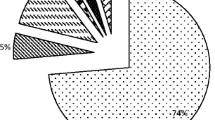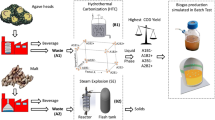Abstract
Solubilization of domestic household waste through steam explosion with subsequent ethanol production by the microbial saccharification and fermentation of the exploded product was studied. The effects of steam explosion on the changes of the density, viscosity, pH, and amounts of extractive components in artificial household waste were determined. The composition of artificial waste used was similar to leftover waste discharged from a typical home in Japan. Consecutive microbial saccharification and fermentation, and simultaneous microbial saccharification and fermentation of the steam-exploded product were attempted usingAspergillus awamori, Trichoderma viride, andSaccharomyces cerevisiae, the ethanol yields of each process were compared. The highest ethanol yield was obtained with simultaneous microbial saccharification and fermentation of exploded product at a steam pressure of 2 MPa and a steaming time of 3 min.
Similar content being viewed by others
References
Sakurai, T. (1992) Present status of domestic wastewater treatment in Malaysia, Indonesia and Thailand.J. Water Waste. 34: 645–651.
Ogawa, T., S. Ohno, and H. Tatsumoto (2000) Quantity and quality of wastewater discharged from various life activities.J. Japan Sewage Works Assoc. Res. J. 33: 19–28.
Tanabe, A., H. Murayama, Y. Mizushima, and Y. Tanikawa (1994) Elimination effect of pollutant loading from kitchen by wastewater management.J. Water Waste. 36: 1036–1040.
Iwahori, K., Y. Sano, S. Honda, and N. Miyata (2000) A novel method of determining cellulosic substrates in raw wastewater and sludge.J. Japan Sewage Works Assoc. Res. J. 33: 121–127.
Mes-Hartree, M., C. N. Hogan, and J. N. Saddler (1987) Recycle of enzymes and substrate following enzymatic hydrolysis of steam-exploded aspenwood.Biotechnol. Bioeng. 30: 558–564.
Morjanoff, P. J. and P. P. Glay (1987) Optimization of steam explosion as a method for increasing susceptibility of sugarcane baggase to enzymatic saccharification.Biotechnol. Bioeng. 29: 733–741.
Nakamura, Y., T. Sawada, and A. Komatsu, H. Sawada, and M. Kawamura (2001) Degradation of kenaf core by steam explosion and saccharification for useful utilization of biowaste.J. Chem. Eng. Jpn. 34: 549–552.
Nakamura, Y., T. Sawada, and E. Inoue (2001) Enhanced ethanol production from enzymatically treated steam-exploded rice straw using extractive fermentation.J. Chem. Technol. Biotechnol. 76: 879–884.
Sawada, T. and Y. Nakamura (2001) Low energy steam explosion treatment of plant biomass.J. Chem. Technol. Biotechnol. 76: 139–146.
Chua, M. G. S. and M. Wayman (1979) Characterization of autohydrolysis aspen (P. tremuloides) lignins.Can. J. Chem. 57: 1141–1149.
Dubios, M., K. A. Gilles, J. K. Hamilton, P. A. Reberse, and F. Smith (1956) Colorimetric method for determination of sugars and related substances.Anal. Chem. 28: 350–356.
Author information
Authors and Affiliations
Corresponding author
Rights and permissions
About this article
Cite this article
Nakamura, Y., Sawada, T. Ethanol production from artificial domestic household waste solubilized by steam explosion. Biotechnol. Bioprocess Eng. 8, 205–209 (2003). https://doi.org/10.1007/BF02935898
Received:
Accepted:
Issue Date:
DOI: https://doi.org/10.1007/BF02935898




